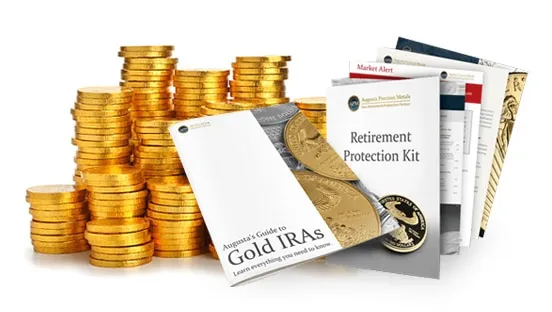Affiliate Disclosure: The owners of this website may be paid to recommend the following companies: Goldco, Augusta Precious Metals, Noble Gold Investments, and Birch Gold. The content on this website, including any positive reviews of the mentioned companies, and other reviews, may not be neutral or independent.
Tax free gold IRA rollover guide. How much will you have to pay in taxes when you retire? The short answer is it depends on the size of your nest egg, the type of investments you’ve chosen, and your tax bracket during retirement. Fortunately, when planning for retirement, you may be able to shelter some of that money from taxation by paying less in taxes now instead of waiting until you’re retired to pay taxes on it all. To learn more about how a tax free gold IRA rollover can work for you as part of your retirement planning, read on to find out how it works and how to get started with one today.
Table of Contents
Tax Free Gold IRA Rollover Guide
Everything you need to know about a tax-free gold IRA rollover
In order to fully understand why tax-free gold IRAs are beneficial, you need to first understand how these accounts work. Most types of retirement accounts will be subject to taxes, and you’ll have to pay a penalty if you withdraw before a certain age. If your employer doesn’t offer a retirement account, or if you are self-employed, then an Individual Retirement Account (IRA) is what can help. It allows you to put money away for retirement each year in an account that isn’t taxed until you make withdrawals. However, some investors might want more control over their investments than they get from traditional IRAs—and that’s where tax-free gold IRAs come in. One of these is a Roth IRA, which works similarly to traditional IRAs in that you can invest money into it. However, you don’t get a tax deduction for your contributions and instead pay taxes on them when you make withdrawals in retirement. Another common type of rollover account is one that holds precious metals, such as gold or silver. With a tax-free gold IRA rollover, your investment grows tax-free while also being protected from inflation because of its inherent value. By choosing to put your retirement funds into precious metals, you can limit how much taxes influence how much money you’ll have available to spend in retirement. Here’s how a tax-free gold IRA rollover works: A typical rollover account is opened and registered with an institution holding your precious metals. This can be a private or government company, depending on what jurisdiction you live in and which type of metal you choose to invest in. After that, you will instruct them to make deposits into your new account each time that you want to invest some money. When you want to withdraw your funds, they will issue you a check made out directly to you or deposited back into your bank account. Everything else is just like other types of IRAs; when it comes time for retirement, as long as you have been contributing consistently, then all of those funds are available for withdrawal without paying any taxes on them.
What are my options?
First and foremost, gold is an alternative to traditional IRAs, and alternative investments provide diversification. If you hold your investment in an IRA it can be placed in a self-directed account allowing you to buy other assets besides precious metals. However, if you are looking to tax free gold ira rollover then there are some restrictions that make moving between types of assets difficult. One restriction is cash flow; you have up to 60 days each year to transfer assets within or out of your IRA as needed. This can pose problems for those who plan on investing only gold or silver in their 401(k) or otherwise because it prevents them from moving out any non-metallic items after one use. Because of these constraints, there are several things you should consider before deciding to tax free gold ira rollover. You should first weigh how much risk you want to take on, if investing for retirement or a longer-term investment horizon then gold may not be right for you. Additionally, many Americans have 401(k)s through their employers and in these cases tax free gold iras and other self-directed investments aren’t an option at all. If you do plan on making these types of investments, it is important to have a solid understanding of how taxes work with regards to your retirement accounts as that can significantly impact how long your savings will last.If you have decided that a tax free gold ira rollover is right for you then there are several other things to consider. In order to set up your account you will need an experienced gold and silver dealer to help facilitate everything. You should also have a clear timeline of how long you expect your money to be invested in these types of assets because they do come with higher risk than your traditional investments. It is important not to fall prey to false sense of security that just because it’s considered a retirement account makes it any safer. For example, precious metals could be subject to market risk and if something were to happen that impacted that market then there could be changes in value, which can result in losses.
Tax Free Gold IRA Rollover Guide

How Much Can I Contribute?
The amount you can contribute to a traditional or Roth IRA depends on your income, filing status and age. To figure out how much you can contribute, use a simple formula: $5,500 (the maximum annual contribution) minus your annual income divided by $100 (the amount of money you can contribute each year). You’ll have to make adjustments based on whether or not you have access to an employer-sponsored retirement plan and your tax-filing status. Keep in mind that any contributions should be taken off your taxable income so it doesn’t count toward your contribution limit. If you are self-employed, contributions are calculated slightly differently because there is no employer-sponsored retirement plan to take into account.There is an annual cap on how much you can contribute each year, with different limits for traditional and Roth IRAs. For 2017, single filers can’t contribute more than $5,500 to a traditional or Roth IRA. Married couples filing jointly are allowed up to $11,000 per person ($13,000 if they’re 50 or older), while heads of household can put away up to $7,000 ($9,000 if they’re 50 or older). The combined income of spouses filing jointly cannot exceed $184,000 in order for them to make full contributions.The maximum you can contribute to a traditional or Roth IRA may increase in future years, but these numbers represent what’s currently allowed. Any contributions made above and beyond those amounts could be subject to an additional tax penalty. There is also a minimum contribution level based on your income that you must adhere to in order to avoid penalties. Your contribution limits are calculated using a formula, so they could be reduced if your income is too high.
Tax Free Gold IRA Rollover Guide

What Type of Gold Bullion Coins and Bars Can I Purchase?
There are three general types of gold bullion that can be purchased and stored in an individual retirement account (IRA): U.S. Mint-issued coins, most notably American Eagle and Buffalo gold coins, as well as one-ounce gold bullion bars issued by private refiners such as PAMP Suisse and Sunshine Minting. Some providers specialize in offering only coins while others carry only bars; some offer both options. The benefit of purchasing government-issued coins is a far lower premium over spot price than what you might find on privately minted bullion; their smaller size also makes them easier to transport and store.The distinction between bullion bars and coins is a matter of size: generally, a one-ounce gold coin will cost around 10 percent more than an equivalent weight in a one-ounce gold bar. That said, both are fine options for retirement portfolios. Bullion bars offer no collectible value outside of their gold content; American Eagle and Buffalo coins derive their premiums from historical factors such as scarcity and popularity, but these premiums may be negated by numismatic market conditions at any given time. Your decision should ultimately depend on how you’ll be using your IRA for storage; if you want to leverage its inherent tax advantages, then bullion coins are probably your best bet.One thing to note is that both bars and coins may be made of more than one metal, including silver. While many gold bullion coins are produced with a core of 99.99 percent pure gold, some coins are alloyed with copper to prevent them from being damaged in storage or transit; American Eagle silver bullion coinage is composed of 91.67 percent silver and 8.33 percent copper, for example. Aside from their different compositions, these silver-gold coins behave like their gold-only counterparts in terms of storage: they are eligible for inclusion in IRAs but may have a lower premium over spot price than all-gold alternatives due to their intrinsic silver value.
Do I need to Pay Taxes on Gains from the Sale of this Bullion?
One of your concerns is probably whether you’ll owe taxes on any gains from selling your bullion. There are two major factors to consider when weighing whether you’ll owe capital gains tax: how long you held onto it and whether it was part of a retirement account. If your bullion was held as a capital asset, like stocks or other investment assets, there are limits on how long you can hold them before they’re treated as a capital asset in trade or business and subjected to capital gains taxes.What is a gold IRA?: A gold IRA, or Individual Retirement Account, allows you to buy precious metals and pay taxes on them now instead of later. If you choose to open an account that has IRS-approved precious metals in it, any growth will be tax-deferred as well. You can choose from a variety of different coins or bars as well. However, if your traditional IRA doesn’t allow for non-traditional investments like bullion in it or you want to diversify into something other than just gold or silver then setting up a self-directed gold IRA may be right for you.Are there limitations on what can be purchased? There are certain coins and bars that your custodian has to hold on to, although you’re not limited to these assets. Some exchanges and bullion dealers like Provident Metals don’t accept non-allocated metals for purchase as they have limitations due to concerns about provenance and other issues. You may also be able to get better prices with a private individual offering his or her metals at auction site such as eBay instead of going through a dealer. If buying gold from another individual, buy only bullion that is at least .995 fine silver, because these products have more liquidity in many parts of the world.
tax free gold IRA rollover guide

Can I Trade in My Existing Retirement Account for a Tax-free Plan?
You may be wondering, What are my options? when it comes to trading in your current account for a tax-free retirement plan. You may not know that you have a choice between doing a rollover of your existing plan or transferring your funds to another tax-free plan. Each option has its own benefits and disadvantages; however, you can benefit from either if you’re willing to do some research on different IRA plans. Here’s what you need to know about both options:Rolling over your current retirement plan, such as a 401(k) or 403(b), into another tax-free account is an option if you like your current financial provider and don’t want to start over. However, many people forget that when they move their funds to a new tax-free account, it becomes subject to different fees and there may be specific restrictions on when you can withdraw from your savings. The major benefit of trading in is flexibility because you can stay with your current provider and still take advantage of your tax-free options. Most providers will offer low-cost investment products so that you won’t have to worry about increased fees once you roll over your plan.If you don’t want to continue using your current provider or feel limited by your provider’s offerings, you can opt for a transfer instead. This involves opening an account with a new provider and trading in your existing funds. Your new tax-free retirement plan may have better investment options and lower fees compared to your old plan, but it will also mean starting over from scratch so that you can get to know a new set of providers. With more investment options, however, you might be able to increase your potential growth over time which could ultimately save you money on taxes as well as make investing less stressful overall.
How Do I Sell My Old Retirement Account and Transfer the Proceeds Into my New One?
Getting your retirement account ready to be sold requires multiple steps. First, you’ll need to go in and remove all of your money, including any investment gains. Then, you have to go in and reconfigure it so that it’s easier for a financial institution or individual investor to buy. And finally, once someone wants to buy into your retirement account (through either sale or an exchange), you’ll need to transfer all of those funds out without incurring fees or taxes. Most people don’t realize how much work goes into making sure they can easily cash out their entire retirement account before they roll it over!The first step is to reconfigure your retirement account to be easier for an investor or financial institution to buy. It may seem strange, but when you roll over your retirement account, you’ll need to take any shares of individual stocks and convert them into a single sum. Your broker will have to sell all of your investments (except government bonds) and turn them into cash before they can give you your new account number. Once that’s done, it’s up to you whether you want those funds invested in some kind of portfolio right away or if you prefer that they sit in cash while you decide what to do with them. Either way, they won’t be accessible until your new bank account has been set up!Once you’ve reconfigured your retirement account, you’ll need to go in and remove all of your funds. This may mean that it takes a few days or weeks before an interested party can buy into your account, so don’t sell too early! If you’re unsure of when to sell, talk to a financial advisor who can help walk you through some potential investment options as well as give advice on whether it’s worth it to hold out for a better deal. With any luck, they’ll be able to help speed up that process so your old accounts are closed and ready for a new owner quickly. Once everything is set up and ready for sale, get in touch with an interested party (either directly or through a broker) and work out terms.
Our Top Gold IRA Company Recommendation:
Augusta Precious Metals makes buying physical gold and silver bullion a breeze with its buy-and-store program. Customers simply open an IRA or Self-Directed 401(k) account, fill out some paperwork, transfer their existing account over, buy a storage plan, and—done!—they’re set up with a physical gold and/or silver they can call their own. Prices on investment-grade gold and silver bullion are always competitive, too.
After deciding that you want a physical precious metals portfolio, then figuring out how and where to buy physical gold and silver is probably next on your list. Fortunately, Augusta Precious Metals makes buying gold easy. Click the banner below, request info, and one of Augusta’s helpful representatives will be in touch with you promptly!





Pingback: Should I Convert My 401k to Gold? - Gold IRA Rollover
Pingback: Tax Free Gold IRA Rollover - Gold IRA Rollover
Pingback: Can You Put Gold in an IRA? - Gold IRA Rollover
Pingback: Setting up a Gold IRA - Gold IRA Rollover
Pingback: A Step by Step Guide: Gold IRA Rollover - Gold IRA Rollover